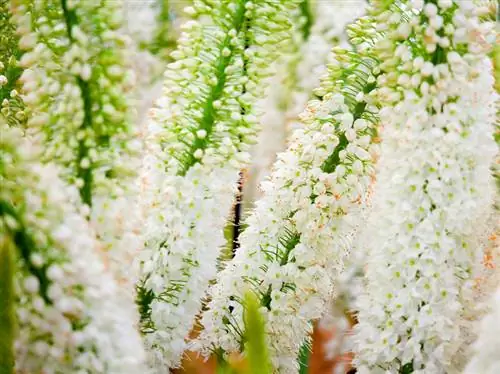- Author admin [email protected].
- Public 2023-12-16 16:46.
- Last modified 2025-01-23 11:20.
The blooming magnificent candle (Gaura lindheimeri) grows to an impressive height of around one meter every year. With a little care, most species of this perennial, also known as prairie candle, can enrich the garden with their flowers for several years in a row.

How do I optimally care for my magnificent candle?
Proper care for the magnificent candle includes regular watering when the soil is dry, repotting in spring, pruning after flowering, sufficient sunlight and, if necessary, light fertilization. Overwintering is possible by storing it frost-proof in a bright room.
How often does the magnificent candle have to be watered?
So that the magnificent candle can optimally develop its long-lasting blooms in summer, it should be planted in a location in the garden that is as sunny as possible. The magnificent candle usually survives shorter dry phases much more easily than a waterlogged location. As soon as the top layer of soil in the perennial bed feels very crumbly and dry during longer dry periods, watering should be carried out in the morning or evening.
When is the best time to repot?
Since the magnificent candles are difficult to repot during the flowering period in summer, you should do this in February or March. Make sure to provide the substrate with a drainage portion of gravel and sand. In this way, you can also prevent the risk of waterlogging and root rot in potted plants.
When and how is the magnificent candle cut?
While some gardeners recommend pruning back the dead parts of the plant only in spring, most people prune directly after flowering in autumn. In this way, overwintering buds can be formed and, if overwintering is successful, the magnificent candle will sprout even wider branches in the new growing season.
What factors lead to deficiency symptoms in the magnificent candle?
The magnificent candle is generally not very susceptible to pests or diseases. However, few flowers form if the plants are positioned too shady in the garden. Other deficiency symptoms and stunted growth are usually due to root rot due to waterlogging of the roots of this sun-loving steppe plant.
Should the magnificent candle be fertilized?
In the open air, no special fertilization is necessary for the magnificent candle other than a regular application of deposited compost to the soil in the perennial bed. For specimens in a bucket, you can mix some liquid fertilizer (€18.00 on Amazon) into the irrigation water every four to six weeks.
How is the magnificent candle optimally overwintered?
Since the magnificent candle is only partially hardy even when pruned in autumn, it should be overwintered in exposed locations under the following conditions:
- as a potted plant in a protected room
- bright
- frost-free
- at temperatures below five degrees Celsius
- with very sparingly dosed moisture
Tip
Even specimens of the magnificent candle that have frozen outdoors can provide another sea of flowers in the garden the following year if you cut back the leaves a little later in the fall and thus allow self-sowing






